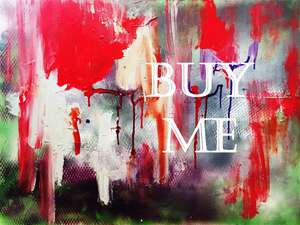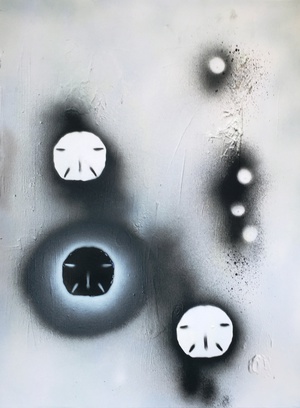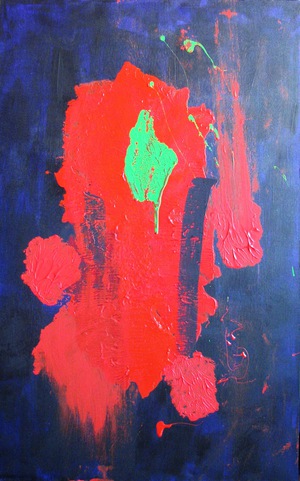New pricing model for 2016!

BREAKING NEWS: I want to sell my art. Not just that, but I want to sell it to YOU, o my reader, who admire my work but thought for so long that of course you couldn't afford a real painting. And not just THAT, but I want to sell it to you for CHEAP (or, OK, for a deeply discounted price).
I've meditated for a bit on this and decided there is one trip I'd really like to go on this year. I want to spend a week at artist Andrea Zittel's Wagon Station Encampment in the desert in the fall. As I'm currently going through a divorce and paying for a mortgage as a newly single person, the only way I can make enough money to do this is to create more fluidity in the world of my art (fancy words for saying that I need to move the merchandise).
So here's how the new pricing model that I've created breaks down:
Example: You want to buy a piece that's 18" x 24" on canvas made with acrylic and spray paint.
Like this one:
"Masks," acrylic and spray paint on canvas, 18" x 24"

So I charge you:
- Canvas: $14 x 2 = $28 [Why the double charge? I am essentially charging you for the materials used to make the piece you are buying PLUS the cost of making another piece of roughly the same size. Also, source for price.]
- Paint: $8 x 2 = $16
- Labor: $25 x 2 = $50
- Subtotal = $94
- 15% of total [I call this my "Trip to Wagon Station Encampment fund"!] = $19
Total = $113. Art just got MUCH cheaper. To put it in perspective, I would usually charge about $225 for a piece this size.
Not bad, right?
Here's another example:
"Impact," acrylic on canvas, 28" x 44"

- Canvas: $38 x 2 = $76 [source for price]
- Paint (there was a lot needed for this one; hence it will be a bit pricier): $15 x 2 = $30
- Labor: $30 x 2 = $60
- Subtotal = $166
- 15% of total [again, for my Trip to the Desert fund] = $33
Total = $199. Again, for perspective: I would usually sell this for about $350-$400.
Some FAQs
"Why are you undercutting your work?"
First, I don't look at it as undercutting, rather as feeding the process and allowing me to have more money for art and to save up for what I see as the trip of a lifetime. Second, I've decided that (with the exception of a few pieces, which I will never sell, for sentimental reasons) one of my main purposes in making my art is to SHARE IT, not let it gather dust in a corner with other canvases. So if that means selling my art for exactly what it cost to make it (plus the cost of making a similarly sized piece), then so be it. It seems like the most rational, fair, and productive solution to me at this times.
"Can I bargain with you on price?"
Yes, within reason, since I'm already reducing my prices so drastically. I also like to barter, but again, I need most of our transaction to be of the currency variety because of the trip I'm trying to make.
"Where can I find the art you have that is for sale?"
Visit Facebook for the most up-to-date information on pieces and then the Art link of this website to see what's a-happening and what's for sale.
"Can I commission a piece for these prices?"
Yes, please! :) Just tell me the following info:
- Timeline (as in, do you need it next week? next month?)
- Medium (canvas? wooden board? acrylic paint?)
- Colors preferred/not preferred
- Any themes preferred (keep in mind I am primarily an abstract artist...)
"How can I buy your work?"
Contact me via email at jesskbarnett at gmail dot com or via the Contact button on this site. Then we can arrange for me to ship to you or meet somewhere locally (I prefer not shipping when I don't have to because of the risk of damage to the piece, but I'm happy to if necessary).
"Do you take American Express?"
I take cash, money order, or check, but sadly, as the ads used to say, not American Express.
"What media do you use?"
Well, here are some things I've used in the past (and could use for your work):
- Traditional: canvas, both stretched and unstretched; canvas board; wooden board; paper for watercolor, pencil, oil pastel, gouache, etc.; acrylic paint; spray paint; watercolor; gouache; colored pencils (not my biggest strength, yet); pencil; cut-out paper
- Less traditional: plywood, screens (as in window screens), silkscreens, rose petals, ashes, wood found in the forest nearby, Oriental bittersweet vines, shells (both incorporated into the piece and used to create shapes), coral, packing material (the white kind with holes; mainly used to create shapes), ferns, blood, Mason jars with spray paint ...
Any other questions, write to me!
